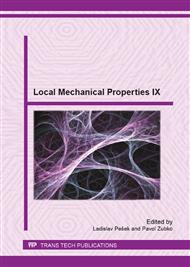[1]
S.G. Larson, A.J. Carlsson, Influence of non-singular stress terms and specimen geometry on small-scale yielding at crack-tips in elastic-plastic materials, J. Mech. Phys. Solids 21 (1973) 263-277.
DOI: 10.1016/0022-5096(73)90024-0
Google Scholar
[2]
J.R. Rice, Limitations to the small scale yielding approximation for crack tip plasticity, J. Mech. Phys. Solids 22 (1974) 17-26.
DOI: 10.1016/0022-5096(74)90010-6
Google Scholar
[3]
Z.Z. Du, J.W. Hancock, The effect of non-singular stresses on crack tip constraint, J. Mech. Phys. Solids 39 (1991) 555-567.
DOI: 10.1016/0022-5096(91)90041-l
Google Scholar
[4]
A.V. Dyskin, Crack growth criteria incorporating non-singular stresses: size effect in apparent fracture toughness, Int. J. Fract. 83 (1997) 191-206.
Google Scholar
[5]
M.R. Ayatollahi, J. Akbardoost, Size effects on fracture toughness of quasi-brittle materials – A new approach, Eng. Fract. Mech. 92 (2012) 89-100.
DOI: 10.1016/j.engfracmech.2012.06.005
Google Scholar
[6]
M.L. Williams, On the stress distribution at the base of a stationary crack, J. of Appl. Mech. 24 (1957) 109-114.
Google Scholar
[7]
M.R. Ayatollahi, M. Nejati, An over-deterministic method for calculation of coefficients of crack tip asymptotic field from finite element analysis, Fatigue Fract. Engng. Mater. Struct. 34 (2011) 159-176.
DOI: 10.1111/j.1460-2695.2010.01504.x
Google Scholar
[8]
B.L. Karihaloo, Q.Z. Xiao, Accurate determination of the coefficients of elastic crack tip asymptotic field by a hybrid crack element with p-adaptivity, Eng. Fract. Mech. 68 (2001) 1609-1630.
DOI: 10.1016/s0013-7944(01)00063-7
Google Scholar
[9]
R.K.L. Su, S.L. Fok, Determination of coefficients of the crack tip asymptotic field by fractal hybrid finite elements, Eng. Fract. Mech. 74 (2007) 1649-1664.
DOI: 10.1016/j.engfracmech.2006.09.009
Google Scholar
[10]
P. Tong, T.H.H. Pian, S.J. Lasry, A hybrid element approach to crack problems in plane elasticity, Int. J. Num. Meth. Eng. 7 (1997) 297-308.
DOI: 10.1002/nme.1620070307
Google Scholar
[11]
Wolfram Mathematica Documentation Center, Wolfram Research, Inc., Champaign, (2007).
Google Scholar
[12]
L. Šestáková, Mixed-mode higher-order terms coefficients estimated using the over-deterministic method, in: Náprstek et al (Eds. ), Proceedings of 18th International Conference Engineering Mechanics, Prague, 2012, pp.1301-1307.
Google Scholar
[13]
V. Veselý, L. Šestáková, S. Seitl, Influence of boundary conditions on higher order terms of near-crack-tip stress field in a WST specimen, Key Eng. Mat. 488-489 (2012) 399-402.
DOI: 10.4028/www.scientific.net/kem.488-489.399
Google Scholar
[14]
V. Veselý, J. Sobek, L. Šestáková, S. Seitl, Accurate description of near-crack-tip fields for the estimation of inelastic zone extent in quasi-brittle materials, Key Eng. Mat. 525-526 (2013) 529-532.
DOI: 10.4028/www.scientific.net/kem.525-526.529
Google Scholar
[15]
L. Šestáková, V. Veselý, Convergence study on application of the over-deterministic method for de-termination of near-tip fields in a cracked plate loaded in mixed-mode, accepted to Appl. Mech. Mat. (2013).
DOI: 10.4028/www.scientific.net/amm.249-250.76
Google Scholar
[16]
L. Šestáková, How to enhance efficiency and accuracy of the over-deterministic method used for determination of the coefficients of the higher-order terms in Williams expansion, accepted to Appl. Mech. Mat. (2013).
DOI: 10.4028/www.scientific.net/amm.245.120
Google Scholar
[17]
L. Šestáková, V. Veselý, J. Sobek, P. Frantík, Z. Knésl, Accuracy of approximation of stress field in cracked bodies for failure zone extent estimation, submitted to VIII International Conference on Fracture Mechanics of Concrete and Concrete Structures (FraMCoS-8).
Google Scholar


